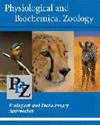Bold Behavior Is Associated with Genes That Regulate Energy Use but Does Not Covary with Body Condition in Food-Restricted Snails.
IF 1.8
3区 生物学
Q3 PHYSIOLOGY
引用次数: 1
Abstract
Theoretical models about the relationship between food restriction and individual differences in risk-taking behavior (i.e., boldness) have led to conflicting predictions: some models predict that food restriction increases boldness, while other models predict that food restriction decreases boldness. This discrepancy may be partially attributable to an underappreciation for animals’ complex physiological responses to food restriction. To understand the proximate mechanisms mediating state-dependent boldness, we used freshwater snails (Helisoma trivolvis) to examine the relationships among food availability, body condition, boldness (latency to reemerge from shell and exploration), and mRNA expression of three genes (adenosine monophosphate–activated protein kinase [AMPK], molluscan insulin-like peptide [MIP], and serotonin receptor [5-HT]) involved in maintaining energy homeostasis during periods of moderate food restriction. Latency to reemerge and exploratory behavior decreased over time, but fed snails were bolder than fasted snails, suggesting that food restriction reduces bold behavior. Although food restriction decreased body condition, there was not a relationship between body condition and latency to reemerge from shell. However, expression of MIP was positively correlated with latency to reemerge from shell. Furthermore, AMPK was positively correlated with MIP and negatively correlated with body condition and 5-HT. Therefore, individual differences in physiological responses to food restriction, not overall body condition per se, appear to be more closely associated with state-dependent bold behavior. Finally, snails that experienced a novel assay environment returned to their initial “shy” behavior, suggesting that habituation to the assay environment may contribute to snails expressing bolder behavior over time.在食物受限的蜗牛中,大胆的行为与调节能量使用的基因有关,但与身体状况无关。
摘要关于食物限制与个体冒险行为差异(即胆识)之间关系的理论模型导致了相互矛盾的预测:一些模型预测食物限制会增加胆识,而另一些模型预测食物限制会降低胆识。这种差异可能部分归因于对动物对食物限制的复杂生理反应的低估。为了了解介导状态依赖性大胆性的近似机制,我们以淡水蜗牛(Helisoma trivolvis)为研究对象,研究了食物可得性、身体状况、大胆性(从壳中重新出现和探索的潜伏期)和三个基因(腺苷单磷酸活化蛋白激酶[AMPK]、软体动物胰岛素样肽[MIP]、和5-羟色胺受体[5-HT])在适度限制食物期间参与维持能量稳态。重新出现的潜伏期和探索行为随着时间的推移而减少,但喂食的蜗牛比禁食的蜗牛更大胆,这表明食物限制减少了大胆的行为。虽然食物限制降低了身体状况,但身体状况与脱壳潜伏期之间没有关系。然而,MIP的表达与脱壳时间呈正相关。AMPK与MIP呈正相关,与身体状况和5-HT呈负相关。因此,个体对食物限制的生理反应差异,而不是整体身体状况本身,似乎与状态依赖性的大胆行为更密切相关。最后,经历了一个新的实验环境的蜗牛恢复了它们最初的“害羞”行为,这表明对实验环境的习惯可能有助于蜗牛随着时间的推移表现出更大胆的行为。
本文章由计算机程序翻译,如有差异,请以英文原文为准。
求助全文
约1分钟内获得全文
求助全文
来源期刊
CiteScore
3.20
自引率
6.20%
发文量
62
审稿时长
6-12 weeks
期刊介绍:
Physiological and Biochemical Zoology: Ecological and Evolutionary Approaches primarily publishes original research in animal physiology and biochemistry as considered from behavioral, ecological, and/or evolutionary perspectives. Studies at all levels of biological organization from the molecular to the whole organism are welcome, and work that integrates across levels of organization is particularly encouraged. Studies that focus on behavior or morphology are welcome, so long as they include ties to physiology or biochemistry, in addition to having an ecological or evolutionary context.
Subdisciplines of interest include nutrition and digestion, salt and water balance, epithelial and membrane transport, gas exchange and transport, acid-base balance, temperature adaptation, energetics, structure and function of macromolecules, chemical coordination and signal transduction, nitrogen metabolism and excretion, locomotion and muscle function, biomechanics, circulation, behavioral, comparative and mechanistic endocrinology, sensory physiology, neural coordination, and ecotoxicology ecoimmunology.

 求助内容:
求助内容: 应助结果提醒方式:
应助结果提醒方式:


